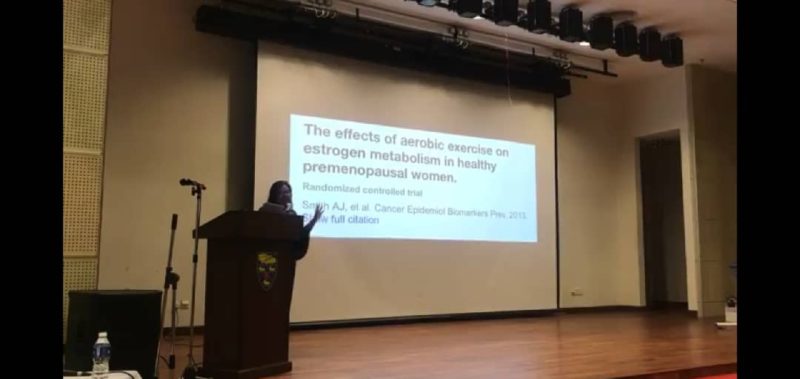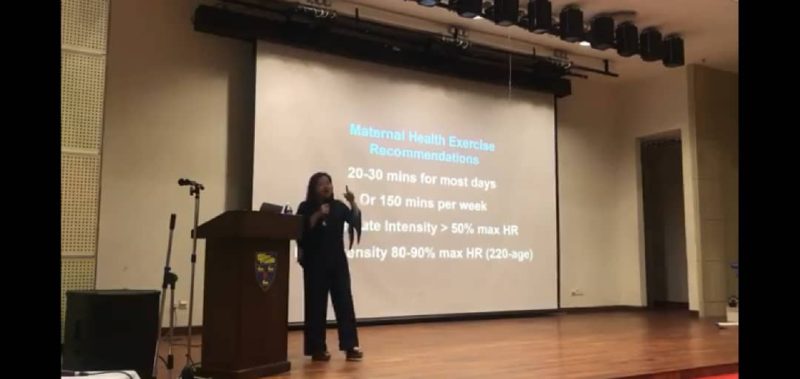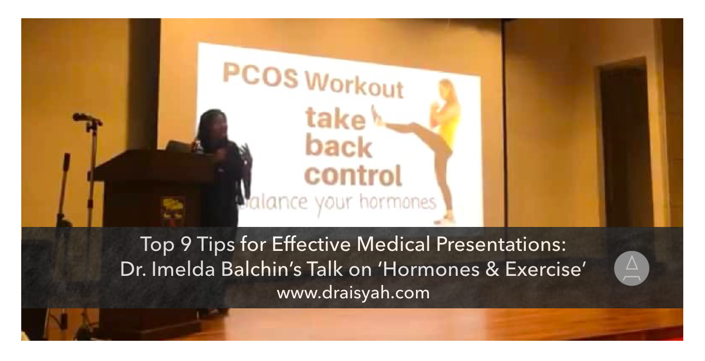What a coincidence! I just came home after a good exercise and found the top post in my FB newsfeed–a talk by Dr. Imelda Balchin. Earlier this year, I shared 3 presentation takeaways from her interview by TV Al-Hijrah. In this post, I share 9 (more) presentation tips culled from Dr. Imelda’s talk at University Malaya (UM).
In the women’s health area, Dr. Imelda doesn’t need an introduction. She has a super-strong following on her talk show ‘Tanya Dr Imelda’ at Astro and FB. Currently, she serves as Consultant Obstetrician and Gynaecologist at KPJ Damansara Specialist Hospital Official.
The talk was delivered at Women in Exercise and Sports Symposium at University Malaya–titled ‘Hormones and Exercise’.
I find Dr. Imeda’s style of presenting to be quite informative and easily understood. We can learn many things from her. You may watch her talk below:
A short analysis of her talk reveals top 9 tips for medical professionals who plan to deliver effective medical presentations. I share the tips below:
1. Craft a simple opening
“Breast cancer is the #1 cancer for women. Colorectal cancer is #2. These can be reduced by exercise. It’s easy to do.”
That’s a simple but great opening statement. It straightaway tells the audience what they are in for.
Whether you like it or not, the first few minutes are critical. Your audience will ‘scan’ you – on how you appear and start the session. If they don’t get the benefits of the talk, they’d shut down. Or turn to their phones.
Another thing, Dr. Imelda stepped on the stage and made a small joke that drew laughters from the audience. Instant connection. Listening mode on.
2. “It’s easy to do”
An awesome hook. Who doesn’t want to know something easy to reduce risks of cancer?
It appeals to one’s curiosity. It draws people in, instead of pushing lots of information to them.
In education, it’s called ‘pull learning strategies’ that is learning based on a learner’s needs, rather than we think they need (push learning). Of course, there should be a balance of push-pull learning.
When things seem easy, that on its own is quite motivating and lead to self-directed learning over time 😉
3. Do you want to know?…
Dr. Imelda continued navigating her audience’s minds with another beautiful hook.
How does it (exercise) do it?
Dr. Imelda Balchin
Do you want to know what’s the mechanism that exercise reduces cancer in women?”
Of course, if you say it’s easy – I want to know how exercise work (in the audience’s minds).
And the first scientific word ‘mechanism’ was introduced here. Even if you don’t know the definition of ‘mechanism’, you already got a clear idea in earlier.
Now her audience can’t wait to know more about the process =)
Three presentation hooks to give your medical presentations a great start. Learn more here.
4. In plain English please
In my recent analysis on Tun Dr. Mahathir’s session at the Columbia University, I shared my thoughts on how Tun M present his ideas well. In a similar vein, have a look at this partial transcript from Dr. Imelda’s talk below:
What do fat cells do?
Dr. Imelda Balchin on ‘Hormones and Exercise’ talk, Women in Exercise and Sports Symposium, University Malaya. 5 October 2019.
Fat cells make oestrogen. This is a hormone that women have more than men…
If you have more fat cells, you make more oestrogen. And that increases your risks – I’ll explain you why.
The more fat you have, you have more insulin growth factors.
You have excess fat, that will increase levels of insulin, causes growth factors to rise which also tell cells to divide more rapidly. And you have more inflammation because of more fat.
Any big medical terminologies here? Can you follow Dr. Imelda’s explanation? And answer, why obesity increases risks in women?
From there on, Dr. Imelda laid out the whole process by telling it in a simple plain English.
It’s so effective – that I cringed (or is it my fat cells cringed?) as I listened to her explanation. Now I want to lose the excess fat😅
5. Use metaphors
Continue watching her talk from minute 5.30. In women, ovulation is a complex process of women’s reproductive system involving the brain, ovaries and several hormones, mainly oestrogens and progestrone.
For the benefit of her audience, Dr. Imelda introduced metaphors i.e. brain (CEO), ovary (a factory), oestrogens (money) and school prefect (progesterone).
I would never associate progesterone with a school prefect. It’s perfect!😆
I also like it that before talking about the ovulation process, she gave a cue,”This is where Science comes in.” That’d prepare the audience for more detailed explanation. An explanation that satisfies curious minds and knowledge-seekers.
To ‘un-complex’ a complicated process, you can use metaphors or break it down into smaller pieces.
Apart from presentation hooks and using a plain English (or Bahasa Melayu) during presentation delivery, many medical presentations would use text, colours and pictures in the slide deck.
6. Picture superiority effect
The bigger a picture is, the more impact it’d have on your audience. If you’re presenting in a small tutorial room that can fit around 30 people, it’s probably okay to use smaller pictures.
But in a big auditorium like this and to maximise impact, it’s best to use 1 big picture to clearly illustrate your point.
Watch from minute 9.22. Here Dr. Imelda showed 2 photos of ovaries with striking differences between normal and polycystic ovary. Just 2 photos – to give a clear idea.
Notice there isn’t any caption. This would ‘force’ the audience to focus listening to your talk to understand about the pictures better.
Using visuals will help make your point easily understood and remembered.

A screen capture of Dr. Imelda’s talk ‘Hormones and Exercise’ showing photos of polycystic ovary syndrome (PCOS)
I know ‘a picture is worth a thousand words’ is a cliche, yet many presentations are still full of text or wordy. More tips on effective slide design here.
In your next medical presentation. use big pictures and a simple language.
7. How to present references
One of ‘presentation bad habits’ in academia is showing a long list of 10 ‘important’ publications on a slide. In font size 14. The presenter then utters a standard script,’These are the references I use in my studies.” Two seconds later, he/she moves on to the next slide.
It’s like ‘now you see it, now you don’t’ as nobody could read the long list… In a day-long symposium, such habit by presenters can be a little irritating.

A screen capture of Dr. Imelda’s talk ‘Hormones and Exercise’ showing an important publication related to her talk.
Instead of doing that, Dr. Imelda showed the title of an important publication along with its authors and journal title. She outlined the study (1-2 sentences), highlighted its significance and relevance to the talk. Watch from minutes 9.40 and 10.50.
Big. Bold. And beautifully-explained.
A great tip for academics and postgraduates too.
8. Text, colours and spacing
Scientific work, methodologies, literature reviews and publications are made up of words that can fill pages and pages of books, theses and reports.
Don’t do the same with your slide deck.
A presentation is not a document.

A screen capture of Dr. Imelda’s talk ‘Hormones and Exercise’.
Examine the slide above. And have a look at her entire presentation.
An interesting mix of slides. No slides upon slides of text… because it’s not a textbook or a document.
I reckon Dr. Imelda selected only the most important recommendations for her audience.
The recommendation slide has 6 lines. Two lines of the heading in fresh sea blue; the rest in white. Big fonts (guesstimate, size 60?) in bold Arial (guessing?). Good balance of text and slides spaces.
Effective use of colours. Firstly, colours are used to separate the heading and main content. Secondly, the white text against the black background. A proven strategy because white/black gives one of the greatest contrast.
For text on slide deck – share only the key points. My personal preference is 3 key points with one big idea–as I mentioned in my book Elevate.
Keeping them short and simple will maximise impact to your audience.
9. Do it like a TED Talk
Dr. Imelda’s talk lasted for nearly 18 minutes. She presented 14 slides with pictures, diagrams, infographics, little text and good use of colours. The slide deck was well-designed to support and illustrate her points.
Just like a TED Talk with a difference.
Because unlike a TED Talk, she wanted interactions with the audience by having a longer Q&A session. It took the audience by surprise initially – perhaps they were expecting a 30-minute talk. Then, slowly questions started coming.
Unfortunately, the session ended abruptly in the middle of Dr. Imelda telling a story about a patient in denial of her own pregnancy…
An engaging session. Wish I could watch until the end.
Final thoughts
“Hormones and exercise”
Had I based my decision solely on the title, I wouldn’t watch the talk 😉
Title aside. The session was delivered by Dr. Imelda Balchin who walks her talks—a mother, a full marathon runner, OBGYN consultant, women’s health expert.
I’d venture to say, it’s probably one of the best medical presentations I’ve seen so far. Very informative, effective and engaging to the public.
Typical academic and medical presentations tend to dry and dull. Nine tips shared above can help you makeover your presentations.
Echoing Dr. Imelda – You can do better than that! =)

Thank you so much for dissecting these tips using Prof Imelda’s presentation. The best example you have used so far. Very helpful!
You’re most welcome. Hope they’d be useful to craft your next preso!